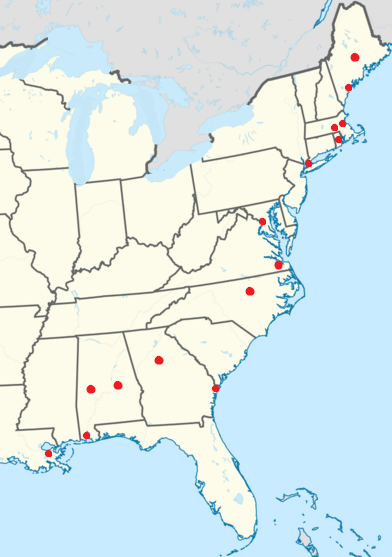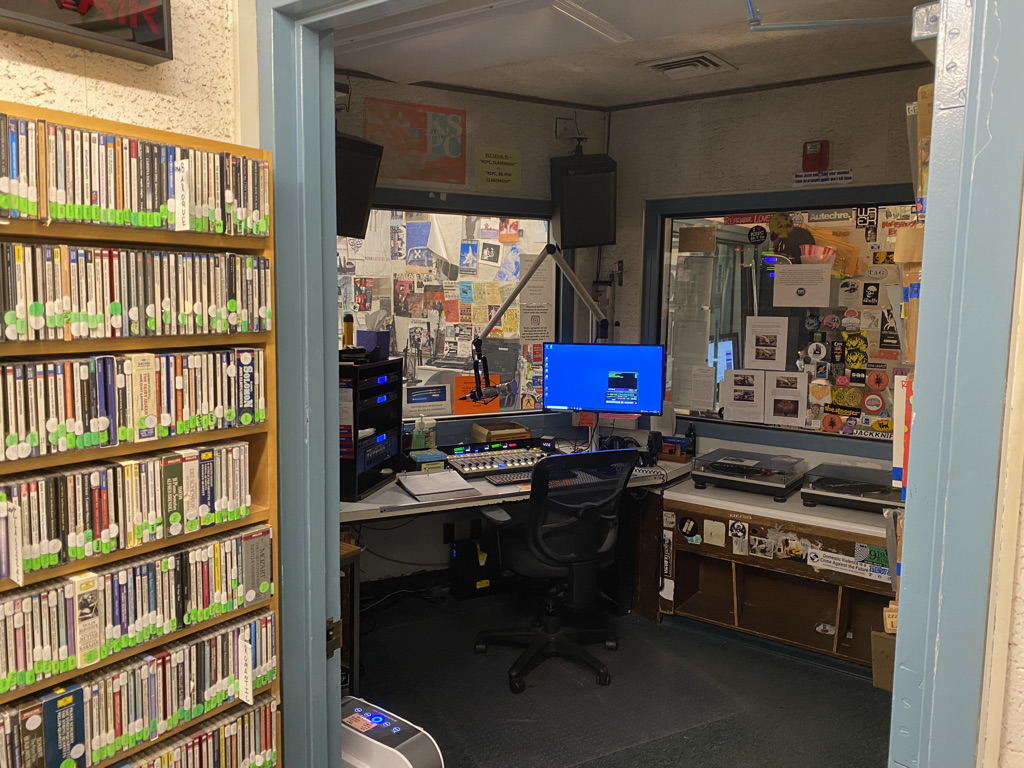|
WPVM-LP
WPVM-LP (103.7 FM) is a non-commercial LPFM radio station licensed to Asheville, North Carolina. The station is owned by Friends of WPVM. History WPVM's construction permit was issued by the Federal Communications Commission The Federal Communications Commission (FCC) is an independent agency of the United States government that regulates communications by radio, television, wire, internet, wi-fi, satellite, and cable across the United States. The FCC maintains j ... (FCC) on December 30, 2002. The station's first broadcast was in October 2003 under a Low Power FM Class 1 license for 100 watts effective radiated power (ERP). After years of financial problems, the station became dormant in 2011—2014. MAIN's board of directors subsequently voted to divest of WPVM to a newly-formed non-profit, Friends of WPVM, in October 2014. One of MAIN's directors attempted to prevent the transfer. There were several other allegations made against several parties during the dispute, o ... [...More Info...] [...Related Items...] OR: [Wikipedia] [Google] [Baidu] |
Asheville, North Carolina
Asheville ( ) is a city in Buncombe County, North Carolina, United States. Located at the confluence of the French Broad River, French Broad and Swannanoa River, Swannanoa rivers, it is the county seat of Buncombe County. It is the most populous city in Western North Carolina and the state's List of municipalities in North Carolina, 11th-most-populous city with a population of 94,589 at the 2020 United States census, 2020 census. The four-county Asheville metropolitan area has an estimated 422,000 residents. History Origins Before the arrival of the European colonization of the Americas, European Colonists, the land where Asheville now exists lay within the boundaries of the Cherokee Nation, which had homelands in modern Western North Carolina, western North and South Carolina, southeastern Tennessee, and northeastern Georgia (U.S. state), Georgia. A town at the site of the river confluence was recorded as ''Guaxule'' by Spanish explorer Hernando de Soto during his 1540 expedi ... [...More Info...] [...Related Items...] OR: [Wikipedia] [Google] [Baidu] |
American English
American English, sometimes called United States English or U.S. English, is the set of variety (linguistics), varieties of the English language native to the United States. English is the Languages of the United States, most widely spoken language in the United States and, since 2025, the official language of the United States. It is also an official language in 32 of the 50 U.S. states and the ''de facto'' common language used in government, education, and commerce in all 50 states, the District of Columbia, and in all territories except Puerto Rico. Since the late 20th century, American English has become the most influential form of English worldwide. Varieties of American English include many patterns of pronunciation, vocabulary, grammar, and particularly spelling that are unified nationwide but distinct from other forms of English around the world. Any North American English, American or Canadian accent perceived as lacking noticeably local, ethnic, or cultural markedness ... [...More Info...] [...Related Items...] OR: [Wikipedia] [Google] [Baidu] |
Free-form Radio
Free-form, or free-form radio, is a radio station programming format in which the disc jockey is given wide or total control over what music to play, regardless of music genre or commercial interests. Freeform radio stands in contrast to most commercial radio stations, in which DJs have little or no influence over programming structure or playlists. In the United States, freeform DJs are still bound by Federal Communications Commission regulations. History in the United States Many shows claim to be the first free-form radio program, but the earliest on record is "Nightsounds" on KPFA-FM in Berkeley, California, D.J.'d by John Leonard. Probably the best-remembered in the Midwest is Beaker Street, which ran for almost 10 years on KAAY "The Mighty 1090" in Little Rock, Arkansas, beginning in 1966, making it also probably the best-known such show on an AM station; its signal reached from Canada to Mexico and Cuba, blanketing the Midwest and Midsouth of the U.S. WFMU is curren ... [...More Info...] [...Related Items...] OR: [Wikipedia] [Google] [Baidu] |
Pacifica Radio
Pacifica may refer to: Art * ''Pacifica'' (statue), a 1938 statue by Ralph Stackpole for the Golden Gate International Exposition Places * Pacifica, California, a city in the United States ** Pacifica Pier, a fishing pier * Pacifica, a conceivable union of Guam, the Northern Marianas, and a number of the former Trust Territories of the United States in the central Pacific Ocean Media * Pacifica Radio, a non-commercial radio network in the United States, founded on the principles of pacifism * ''Federal Communications Commission v. Pacifica Foundation'', a landmark court case for the regulation of indecency in U.S. broadcasting * ''Pacifica'', a newsletter published by the Association of Pacific Coast Geographers * ''Pacifica'' (journal), theological journal Music * ''Pacifica'' (Fred Frith album), 1998 * ''Pacifica'' (The Presets album) * Pacifica Quartet, an American string quartet * Yamaha Pacifica, a model of electric guitar Fictional * Pacifica, a planet in "Man ... [...More Info...] [...Related Items...] OR: [Wikipedia] [Google] [Baidu] |
FM Broadcasting
FM broadcasting is a method of radio broadcasting that uses frequency modulation (FM) of the radio broadcast carrier wave. Invented in 1933 by American engineer Edwin Armstrong, wide-band FM is used worldwide to transmit high fidelity, high-fidelity sound over broadcast radio. FM broadcasting offers higher fidelity—more accurate reproduction of the original program sound—than other broadcasting techniques, such as AM broadcasting. It is also less susceptible to Electromagnetic interference, common forms of interference, having less static and popping sounds than are often heard on AM. Therefore, FM is used for most broadcasts of music and general audio (in the audio spectrum). FM radio stations use the very high frequency range of radio frequency, radio frequencies. Broadcast bands Throughout the world, the FM broadcast band falls within the VHF part of the radio spectrum. Usually 87.5 to 108.0 MHz is used, or some portion of it, with few exceptions: * In the Commo ... [...More Info...] [...Related Items...] OR: [Wikipedia] [Google] [Baidu] |
LPFM
Low-power broadcasting is broadcasting by a broadcast station at a low transmitter power output to a smaller service area than "full power" stations within the same region. It is often distinguished from "micropower broadcasting" (more commonly " microbroadcasting") and broadcast translators. LPAM, LPFM and LPTV are in various levels of use across the world, varying widely based on the laws and their enforcement. Canada Radio communications in Canada are regulated by the Radio Communications and Broadcasting Regulatory Branch, a branch of Industry Canada, in conjunction with the Canadian Radio-television and Telecommunications Commission (CRTC). Interested parties must apply for both a certificate from Industry Canada and a license from CRTC in order to operate a radio station. Industry Canada manages the technicalities of spectrum space and technological requirements whereas content regulation is conducted more so by CRTC. LPAM stations are authorized to operate with less t ... [...More Info...] [...Related Items...] OR: [Wikipedia] [Google] [Baidu] |
Federal Communications Commission
The Federal Communications Commission (FCC) is an independent agency of the United States government that regulates communications by radio, television, wire, internet, wi-fi, satellite, and cable across the United States. The FCC maintains jurisdiction over the areas of broadband access, fair competition, radio frequency use, media responsibility, public safety, and homeland security. The FCC was established pursuant to the Communications Act of 1934 to replace the radio regulation functions of the previous Federal Radio Commission. The FCC took over wire communication regulation from the Interstate Commerce Commission. The FCC's mandated jurisdiction covers the 50 states, the District of Columbia, and the territories of the United States. The FCC also provides varied degrees of cooperation, oversight, and leadership for similar communications bodies in other countries in North America. The FCC is funded entirely by regulatory fees. It has an estimated fiscal-2022 budg ... [...More Info...] [...Related Items...] OR: [Wikipedia] [Google] [Baidu] |
2004 Establishments In North Carolina
4 (four) is a number, numeral and digit. It is the natural number following 3 and preceding 5. It is a square number, the smallest semiprime and composite number, and is considered unlucky in many East Asian cultures. Evolution of the Hindu-Arabic digit Brahmic numerals represented 1, 2, and 3 with as many lines. 4 was simplified by joining its four lines into a cross that looks like the modern plus sign. The Shunga would add a horizontal line on top of the digit, and the Kshatrapa and Pallava evolved the digit to a point where the speed of writing was a secondary concern. The Arabs' 4 still had the early concept of the cross, but for the sake of efficiency, was made in one stroke by connecting the "western" end to the "northern" end; the "eastern" end was finished off with a curve. The Europeans dropped the finishing curve and gradually made the digit less cursive, ending up with a digit very close to the original Brahmin cross. While the shape of the character f ... [...More Info...] [...Related Items...] OR: [Wikipedia] [Google] [Baidu] |
Community Radio Stations In The United States
A community is a social unit (a group of people) with a shared socially-significant characteristic, such as place, set of norms, culture, religion, values, customs, or identity. Communities may share a sense of place situated in a given geographical area (e.g. a country, village, town, or neighborhood) or in virtual space through communication platforms. Durable good relations that extend beyond immediate genealogical ties also define a sense of community, important to people's identity, practice, and roles in social institutions such as family, home, work, government, TV network, society, or humanity at large. Although communities are usually small relative to personal social ties, "community" may also refer to large-group affiliations such as national communities, international communities, and virtual communities. In terms of sociological categories, a community can seem like a sub-set of a social collectivity. In developmental views, a community can emerge out of a coll ... [...More Info...] [...Related Items...] OR: [Wikipedia] [Google] [Baidu] |
Low-power FM Radio Stations In North Carolina
Low power may refer to: * Radio transmitters that send out relatively little power: ** QRP operation, using "the minimum power necessary to carry out the desired communications", in amateur radio. ** Cognitive radio transceivers typically automatically reduce the transmitted power to much less than the power required for reliable one-way broadcasts. ** Low-power broadcasting that the power of the broadcast is less, i.e. the radio waves are not intended to travel as far as from typical transmitters. ** Low-power communication device, a radio transmitter used in low-power broadcasting. * Low-power electronics, the consumption of electric power is deliberately low, e.g. notebook processors. * Power (statistics), in which low power is due to small sample sizes or poorly designed experiments See also * Power (other) Power may refer to: Common meanings * Power (physics), meaning "rate of doing work" ** Engine power, the power put out by an engine ** Electric power, a type of e ... [...More Info...] [...Related Items...] OR: [Wikipedia] [Google] [Baidu] |
Radio Stations Established In 2004
Radio is the technology of communicating using radio waves. Radio waves are electromagnetic waves of frequency between 3 hertz (Hz) and 300 gigahertz (GHz). They are generated by an electronic device called a transmitter connected to an antenna which radiates the waves. They can be received by other antennas connected to a radio receiver; this is the fundamental principle of radio communication. In addition to communication, radio is used for radar, radio navigation, remote control, remote sensing, and other applications. In radio communication, used in radio and television broadcasting, cell phones, two-way radios, wireless networking, and satellite communication, among numerous other uses, radio waves are used to carry information across space from a transmitter to a receiver, by modulating the radio signal (impressing an information signal on the radio wave by varying some aspect of the wave) in the transmitter. In radar, used to locate and track objects like ai ... [...More Info...] [...Related Items...] OR: [Wikipedia] [Google] [Baidu] |








